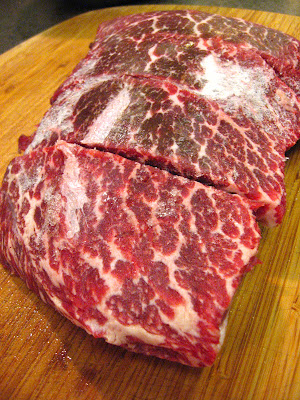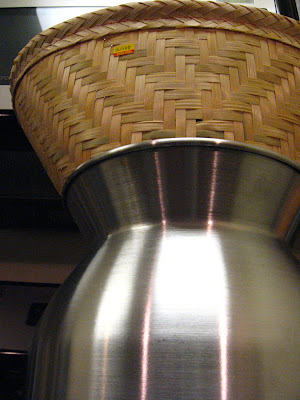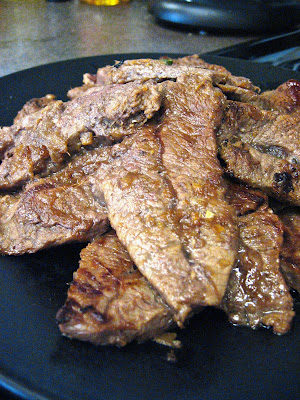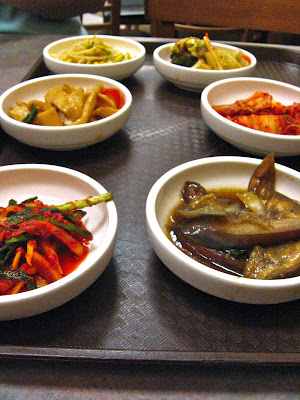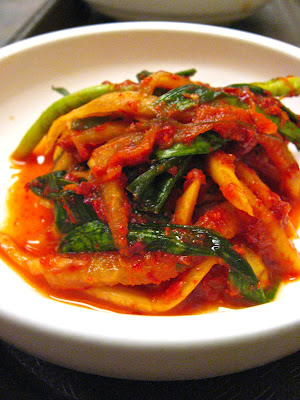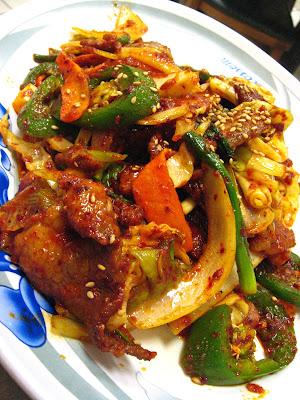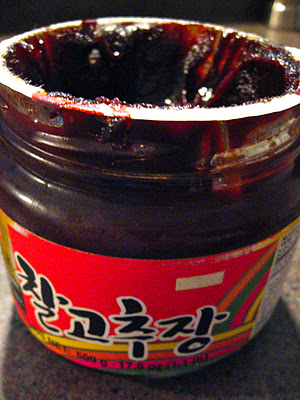Visit Simple, Good, and Tasty for the newest installation of Farm To Fork, A CSA Series where I address vegetable fatigue. Find out how I put zucchini and corn to work in chocolate zucchini bundt cake and Korean Pa Jun filled with bulgogi and sweet corn.
Category: Korean (Page 3 of 4)
Because this cut of meat is usually slow-cooked, I cut them into slices and soaked them for 18 hours in galbi marinade, to break down its connective tissue.
I served the short ribs along with lettuce for wrapping, julienned carrots, tart kimchee, gochujang, and Thai sticky rice.
Thai rice is usually steamed in a traditional metal pot and basket set. Sticky rice is a delightful treat for a tired palate. Plus, it’s a fun, moldable tool to transport food to mouth. A pot and steamer basket will run about $10.
Both are available at the Asian & American Market in Fargo, ND for $13. Look for glutenous or sweet rice from Thailand. I found several varieties at the Asian & American Market ranging from $6-14.
 |
| I know what you are thinking. Don’t. |
This meal is definitely slow food. Plan to marinate your kalbi overnight and soak your rice the morning of.
Marinating Your Galbi
I used the same galbi marinade recipe from my post Flipping Amazing Galbi, reducing the quantity for my short ribs. Feel free to vary from the recipe and, as always, add more or less ingredients to taste. This time around, I reduced the sugar, honey, & soda and added two, thinly sliced Thai chilies. The Asian pear is essential to tenderizing the meat.
| My lovely sea foam green bowl. |
Ingredients:
1/2-1/3 cup soy sauce or tamari
1 Asian pear, grated with juices (available at Hornbachers)
2 Tablespoons of minced garlic
1/2 onion, peeled and grated, with juices
1 Tablespoon of grated ginger (you can leave the skin)
2 Tablespoons of light brown sugar
1 Tablespoon of honey
2 1/2 Tablespoons of sesame oil
1 Tablespoon of ground cayenne pepper or fresh chilies
1/4 teaspoon of black pepper
2 green onions, thinly sliced
Lemon-lime soda, about 20 ounces
Simply, mix the ingredients together and add the short ribs. Marinate in the refrigerator, covered, overnight.
To cook, drip off the extra marinade and cook on a hot grill or pan until the meat reaches your desired level of doneness.
Serve with Thai sticky rice, julienned vegetables, gochujang, kimchee, and lettuce for wrapping.
To Make Thai Sticky Rice
Pour as much sticky rice as you need into a large bowl. Rinse until the water is mostly clear. Swish the rice around in the water and gently pour out the water, repeating a few times.
Allow the rice to soak in the clear water for at least four hours. Since I hadn’t made sticky rice for years, I enjoyed this refresher from Blazing Hot Wok whose author recommends soaking while at work.
Fill the pot with a few inches of water and heat to medium-high.
Drain the rice and pour into the steamer basket. Place the basket over the pot and cover with a lid.
Steam the rice for about 10-15 minutes after the water starts to boil. Gently shake the basket and try to flip the ball of rice so the other side can steam evenly. Keep tasting the rice until its texture is tender but not mushy.
When its finished, place in a bowl and cover with a towel. You can also buy a traditional basket for holding cooked rice.
Solo Road Trip Home Part II continues here.
I was pleasantly surprised when my folks agreed to a meal at Dong Yang, a tiny Korean restaurant located inside a tiny Korean grocery store, connected to a hardware store in Hilltop, MN (near Fridley and Colombia Heights).
Dong Yang
735 45th Ave NE
Hilltop, MN
When I lived near Theodore Wirth Park, I occasionally ordered take-out from Dong Yang. Since my folks recently moved to Shoreview, it seemed like a shame not to take advantage of the close proximity.
J. is an adventurous diner who is fond of spicy food, while Dad has always preferred his food mild and well-done. I prepped them about Dong Yang’s stern Korean grandmother-style of service and they assured me they were ready. Despite my dad’s disdain for kimchee.
We meandered through Dong Yang’s grocery store to the small kitchen that bustled with customers. Although most of the tables were full, a gentleman graciously led us to an open seat.
I immediately noticed an illuminated menu with prices and photographs above the counter. Gone were the pieces of 8 X 11 paper with menu items handwritten in Korean. An arched entryway punctuated the back of the dining room where there had once stood a solid wall.
J. ordered the spicy pork stir fry, Dad chose beef bulgogi, and I ordered the kalbi shortribs. When Dad handed the woman the credit card to pay our bill, she flung the card into the air and let it crash down onto the counter, where it rattled to a halt. This sequence occurred within the blink of an eye and was performed in a comically, nonchalant manner.
We froze in confusion as we tried to figure out how the card flew up into the air. Finally, she broke the silence by saying “No MasterCard.” Her deadpan expression softened a bit. Dad muttered “you were right” from the corner of his mouth and I just nodded and smiled as I tried not to crack-up.
After we settled, we were brought a beautiful tray of banchan, delightful little dishes of Korean appetizers and pickles, perfect for cutting the richness of meat. We also received our own little bowl of rice.
Our spread included spicy, assorted kimchees and milder dishes like slightly sweet beansprouts, marinated strips of fishcake, eggplant and a cabbage salad of sorts.
Besides the traditional cabbage kimchee, my favorites included the eggplant and this spicy version kimchee made with different vegetables.
Shortly after, the kitchen began to set our entrees on the counter. J’s spicy pork stir fry was indeed spicy.
Much spicier than the version Jake used to order from Hoban, and plush with fresh veggies like sliced jalapeno, thinly shaved carrot, and silky cabbage. The sauce was delightfully spicy, perfectly balanced to the point of tasting addicting, and complicated in flavor. This is definitely my favorite and spiciest version this type of pork dish I have ever tried in a local Korean restaurant. When I return, I will order another serving.
Dad’s beef bulgogi was savory and sweet.
The slices of beef were thin, though one slice I tried was slightly dry. I’m a sucker for beef bulgogi so I still considered it delicious. He complained a bit about some fatty bits of meat he had to pick around, a taste and texture to which I’ve become accustomed or acquired the taste.
My galbi short ribs were plush and flavorful. Some of the meat was medium rare, a treat in my book.
They were a bit chewy, but not enough to complain about and I enjoy working for my meat. Similar to chicken wings and crab, I don’t mind navigating around bone and cartilage, and savoring small bits of melting fat.
During a lull, the staff took a break to enjoy a staff meal and I admired the mysterious and delicious-looking contents in their bowls and pots.
After we finished eating, we stood up to leave and had almost passed through the dining room’s doorway when we heard the same woman hollering at us. When she repeated “self-serve” we realized she was trying to tell us to pick up our dang dishes, so we scurried back to clear our table.
On the way out, we explored the restaurant and curiously eyed a row of tables near the entry, displaying plastic bins of mysterious treats. All of the items were available for sampling, suggested by a plethora of toothpicks.
I didn’t feel brave enough to taste tiny, preserved fish soaking a vibrant red brine, nor preserved sea squirt. Yes, sea squirt. The same, pulsating, ruby red creature Andrew Zimmern sampled in Japan on Bizarre Foods.
All in all, the food was divine and the dining experience an adventure. The prices of soups and entrees ranged around $8.99-$13.99 and the portion sizes were plentiful. And remember, that banchan always comes with the meal. I love Korean food, I love Dong Yang, and I love the Korean grandmothering I never received. There’s nothing like making up for lost time.
Brace yourself for another non-recipe recipe.
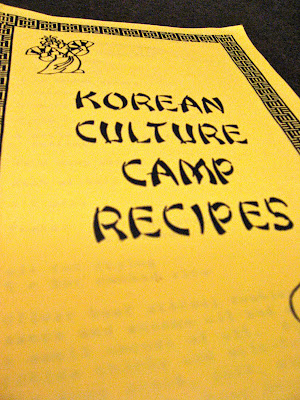 The art of recipe writing is a skill in which I could stand to improve. Each time I set out to adapt or create a recipe for blogging purposes, I’m caught in a whirlwind of improvisation. Before I realize it, I’m left with another non-recipe recipe.
The art of recipe writing is a skill in which I could stand to improve. Each time I set out to adapt or create a recipe for blogging purposes, I’m caught in a whirlwind of improvisation. Before I realize it, I’m left with another non-recipe recipe.
Recently, my family unearthed this old Korean Culture Camp recipe booklet.
I don’t recall much about my childhood summers at Korean Culture Camp, except that the tomboy inside of me was terrified of performing the fan dance in a hanbok, and I always looked forward to lunch.
Minnehaha Academy’s cafeteria was taken over by Korean cooking and campers ate kimchi, fried rice, and mandu on plastic lunch trays. Just for the record, I’ve always liked kimchi.
My Korean Culture Camp booklet includes a simple beef and cucumber stir-fry, a perfect meal for a Friday evening. Not quite a week night and not quite a weekend.
I substituted tender pork for beef and spiked the marinade with a split habanero and cayenne pepper. I started by following the booklet’s recipe and added more ingredients to amp up the flavor. The sesame seeds add a nutty flavor that is rich like peanut butter. Overall, it’s a highly addictive dish that I enjoyed for breakfast, lunch, and dinner.
The ingredients, below, provide a rough guide for 1/3-1/2 pound of meat. You only need enough marinade to coat your meat. If you do not have mirin, sweeten the soy sauce with sugar or honey until you like its flavor. As you cook the meat and vegetables, savory juices will meld with the marinade and create a umami-filled sauce.
Start with equal parts soy sauce and tamari and test for balance (I preferred a little more soy). The rest of the ingredients can be added to taste, but use the sesame oil sparingly, as it’s very fragrant.

Ingredients
2-3 cucumbers, sliced
Mushrooms, sliced
About 1/3 lb of a tender cut of boneless pork (frozen meat is easier to thinly slice)
2 tablespoons of soy sauce or tamari
2 tablespoons of Mirin
1/2 tablespoon sesame oil
2 scallions, sliced, plus extra for garnish
2 teaspoons sesame seeds
Ground ginger, a dash (or a glob of freshly grated ginger)
Black Pepper
Optional: Cayenne Pepper (to taste)
Optional: Habanero Pepper, split
- Peel the cucumbers and cut them in half (hot dog style). Scoop out the seeds. Slice the cucumber halves and let them sit in a strainer with a sprinkle of salt for 1/2 hour to eliminate extra moisture.
- Make the marinade by combining a couple tablespoons each of mirin and soy sauce. Taste for balance, and add more soy sauce, mirin, or sugar if needed.
- Stir in the sesame oil, chopped scallion, sesame seeds, ginger, black pepper. If you like things hot, add cayenne pepper. If you like things hotter, try splitting open a fresh habanero pepper and allowing it to soak in the marinade.
- Add the thinly sliced pork to the marinade and allow the flavors to mingle for at least 15-minutes.
- Preheat a pan over medium-high heat with a couple tablespoons of oil (not olive oil). Stir-fry the mushrooms until tender and caramelized and set aside. Then, add the beef with its marinade and stir-fry.
- Add the sliced cucumber to the beef and stir fry for about a minute. Then add the mushrooms back to the pan and allow everything to briefly simmer, continuing to taste for seasoning.
- Serve over steamed rice and garnish with more scallion.
Following my quest to make chap chae, I embarked on a journey to make galbi.
In the Twin Cities, Jake and I have eaten versions of galbi, tender and succulent marinated short ribs, grilled until charred. The traditional galbi cut of meat is very much Korean, and difficult to locate in Fargo. My friend’s husband made a delicious version of galbi with boneless meat Hornbachers specially sliced.
To enjoy, try wrapping these short ribs in crisp lettuce leaves alongside steamed rice and kimchee.
In my last post, I wrote about visiting a small Korean grocery store called Everday Mart in Fargo.
When I asked the owner about galbi, he showed me a supply of frozen short ribs that cost $40/four pound box, or sold by the pound.
I bought about half a box which would serve approximately 2-3 people.
Directions:
2. Remove short ribs from the refrigerator. Drain the excess marinade, and let them come closer to room temperature. In the meantime, wash and dry the lettuce leaves and prepare steamed rice.
3. To steam rice: Rinse your rice in a mesh strainer. Place the rice in a saucepan with twice as much water. Bring to a boil, stir, and cover. Immediately reduce the heat to low and let steam for about 30 minutes. You can open the lid briefly to peek on the rice and taste for doneness, but whatever you do, do not stir the rice before its done steaming. Otherwise it will become gummy.
4. Cook your galbi in a hot pan or grill. I used an electric griddle, but use whatever method you have available. Broiling would probably work as well. A hotter temperature will more easily caramelize the fat into melting bliss. Leave the galbi on the skillet enough to develop caramelization or cook to your desired doneness. Lengthy marination will make sure they remain juicy and tender, no matter their doneness.
The finished short ribs were every bit as delicious as those we’ve enjoyed at Korean restaurants. Juicy, tender, and moist. If you use traditional Korean short ribs, you will have to navigate around the bone and fat by nibbling and pulling the meat apart with your fingers. I enjoy this process, but a boneless cut of meat will ensure easier lettuce wrapping.
Try gochujang, Korean fermented red pepper paste. This condiment is salty, sweet, and spicy, a perfect compliment to the lettuce wraps.
I bought a jar of gochujang (Wang brand) at the Asian and American Market in Fargo. It worked in a pinch, but tasted sharp and contains corn syrup and MSG. Our friends’ version was mellower and more nicely balanced, so invest in a higher quality gochujang.
Fargo, ND 58102
701-232-2266

